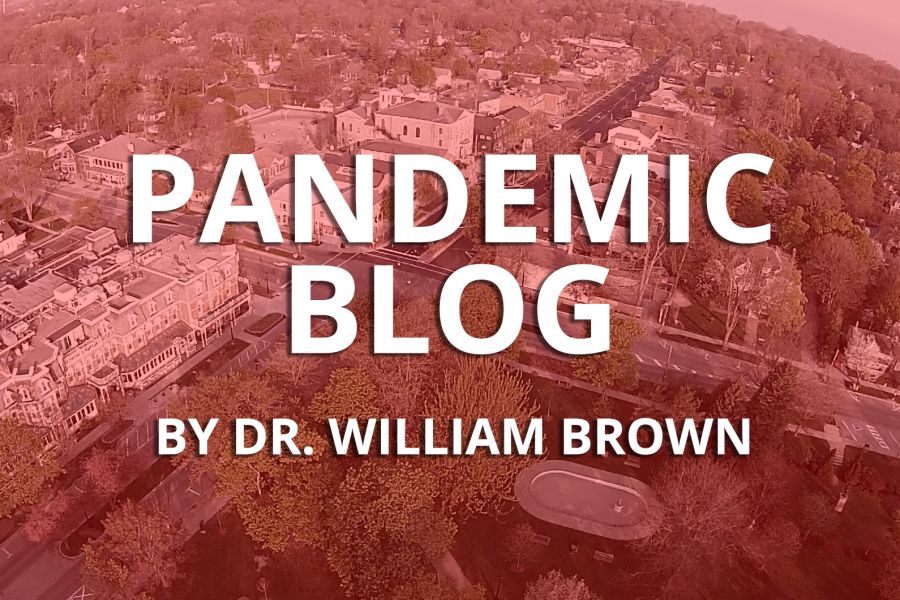Dr. William Brown
Special to The Lake Report
Ever since COVID-19 emerged in China in late November this virus has kept the experts guessing. Despite similarities to SARS – with which COVID-19 shares 80 per cent of its genome and the lethal nature of both diseases once they strike the lower respiratory track – COVID-19 is different.
For one, it is far easier to catch than SARS, so far infecting more than six million worldwide so far, unlike SARS where there were several thousand cases. Moreover, COVID-19 attacks many more tissue targets, including the clotting and vascular systems, kidneys, bowel, liver and even the brain, and eyes – unlike SARS.
Throughout this pandemic, governments and experts struggled with conflicting urgencies.
First there was the urgent need to deal with thousands of patients, some of whom were seriously ill whose needs threatened to overwhelm health care systems. Linked to that was the need to stem the tide of the disease by reducing social contacts by shutting down schools, venues such as bars and restaurants and businesses.
Now when the price tag of shutting down economies has become intolerable, there’s a rush with the first blush of summer coming, to ‘reopen’ and revive economies on the brink of collapse in the face of the worst recession in decades.
The two main reasons COVID-19 created such worldwide havoc in such a short time are simple. Unlike SARS, Covid-19 turned out to be highly transmissible.
And second, many of those infected, especially the young, had few, if any symptoms, and unwittingly spread the virus for up to two weeks. The most effective measures to stem the tide of the pandemic have been isolation of the most vulnerable such as the aged and those with significant pre-existing conditions from contact with anyone who might have the disease and social distancing.
That, and widespread cancellation of natural social activities such as sporting events, bars and restaurants, helped “flatten the curve” and reduced the immediate risk to the vulnerable. And so far, where practised, those strategies worked, especially when those measures were coupled with vigorous contact tracing and widely available testing for the virus – measures South Korea continues to carry out.
However, until effective vaccines become available sometime next year, the vulnerable will remain just as vulnerable as before until their chance of becoming infected with the virus becomes significantly reduced through the “herd effect.”
For example, when the pandemic first struck communities, there was no natural immunity, but at the outset at least, the chance of becoming infected was low, because there weren’t enough infected spreaders in the community.
However, within a few weeks, as the number of spreaders increased exponentially within the community, the chance of infecting others increased dramatically. And thus, the number of those severely affected spiked, many of whom died – a rapid-fire succession of tragic events – which played out over a few weeks in New York City as the first major city in the Americas to he hit hard.
The pandemic struck long-term-care facilities the hardest, accounting for 50 to 80 per cent of the deaths in communities throughout Europe and the Americas.
However, once 70 to 80 per cent of a community acquires natural immunity to COVID-19 through a previous infection (or an effective vaccine), the risk to the vulnerable is much less because the chance of them contacting someone actively “shedding” the virus – symptomatic or not – is much reduced.
That’s the herd effect: those with immunity provide a firewall against the spread of the virus. However, there’s much to be learned about this virus.
How effective is acquired immunity to a second infection with this virus and related to that question, how long does the immunity last? The same questions apply to any prospective vaccination program. How effective is the vaccine in preventing or muting any naturally acquired infection with the virus and how long does the vaccine work?
Good questions, because in the case of the common cold, caused by other coronaviruses, immunity lasts only a few months, and only a year or so in the case of an unrelated virus such as the influenza virus and about two years in the case of the closely related SARS virus.
Right now, in North America and Europe, we’re nowhere near the 80 to 90 per cent of the population with an acquired immunity to COVID-19 needed to provide herd immunity for the vulnerable.
In most communities, that number is somewhere between 10 and 20 per cent. Based on that, especially without an effective vaccine, the vulnerable will continue to be vulnerable for many months to come – possibly a year or longer or until an effective vaccine becomes available.
That’s not good news for Niagara-on-the-Lake, roughly half of whom are over 60 years of age, and many of whom have one or more comorbid conditions. So, be warned in Niagara-on-the-Lake – this battle is not over by a long shot, for us.
* How does COVID-19 affect your lungs? Read more on our Pandemic Blog https://www.niagaranow.com/opinion.phtml/3942.
Dr. William Brown is a professor of neurology at McMaster University and co-founder of the Infohealth series held on the second Wednesday of each month at the Niagara-on-the-Lake Public Library.










